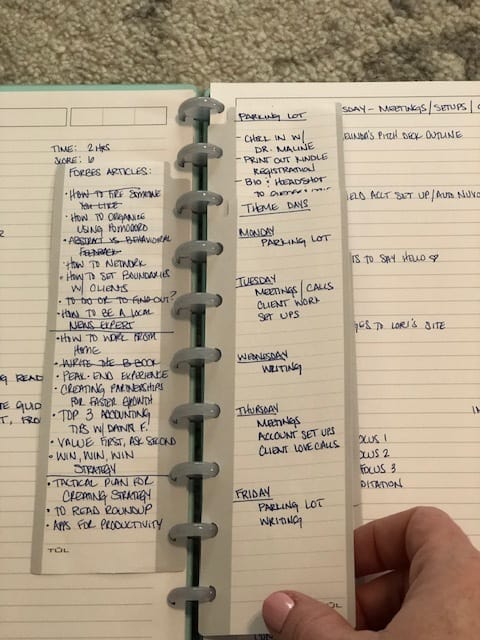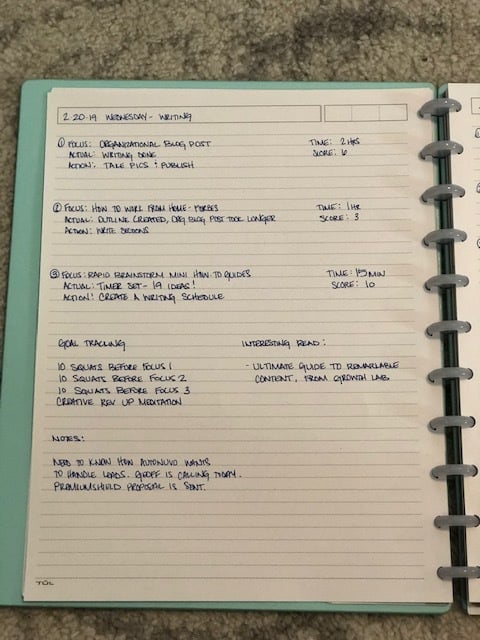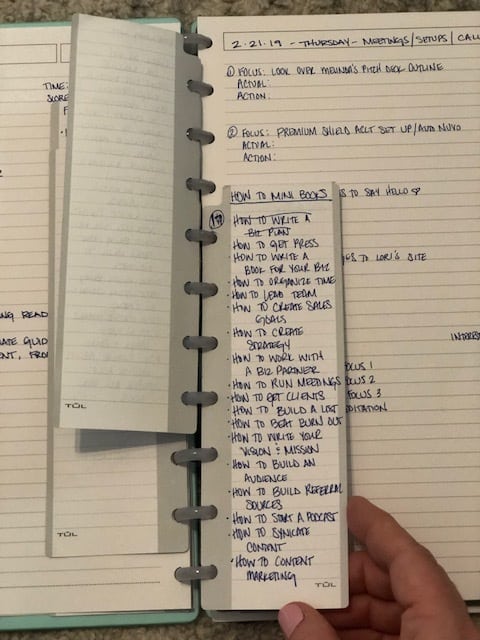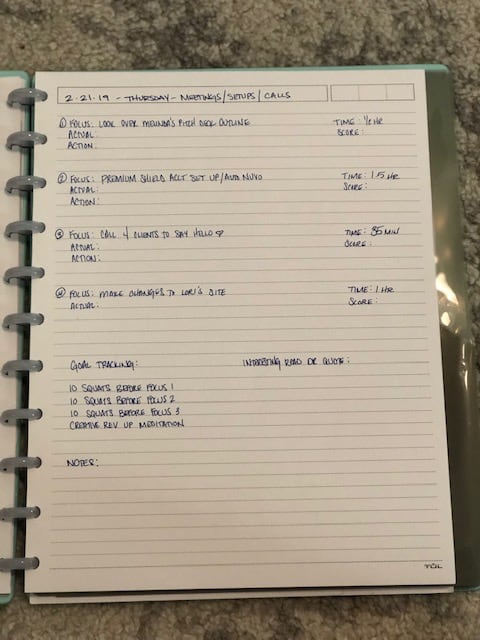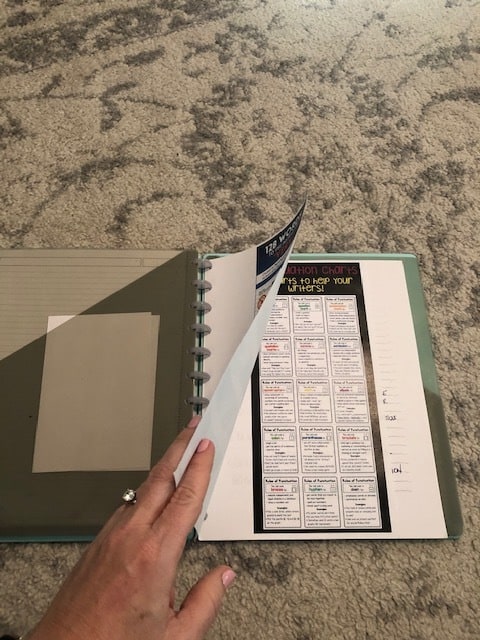How To Tame Squirrel Brain
A Productivity PlanHow To Be More Productive
Current situation: Home all day with a 3 year old and a 1 year old. #sendhelp #bringwine #whatwasithinking
If you work from home, you know there are distractions around every corner – sometimes with sticky fingers holding cheese and crayons. It can be really hard to be more productive.
Now that I’m juggling more than just myself and my business, I have to get really intentional with the little free time I do have (aka: nap time).
Even if you don’t have kids, keep reading, you most likely still have distractions and could benefit from getting maximum output from the time you put in.
I’ve developed my own system for planning what I need to get done in a day by borrowing some strategies from other amazing entrepreneurs. I am going to outline how I stay productive while keeping tiny grape jelly handprints off of my computer screen.
I was gifted the TUL notebook and let it sit in my closet for probably a year. I didn’t think I needed it, since at the time I was pregnant with my first babe and plenty productive. Once she got here though, my time for work was cut by about 110% and I realized how much time I was actually wasting. So I busted out the notebook to see if I could use it to help me get things done.
And Boy Did It Ever
Disc bound notebooks are gaining popularity because it’s like combining a spiral notebook with a binder. You can add and take away pages, rearrange them, take pages out to write notes and put them back – it’s just really clever.
So here’s how I use my Tul system to keep the chaos under control. These are actual pictures of my Tul notebook.
The key parts:
- Themed Days
- 3 Things That Must Get Done
- Parking Lot
- Tracking
Tools:
- Tul Discbound Notebook (Or one of these brands: Talia Brand • Staples Arc • Martha Stewart )
- Timer (you can use your phone, but I like this adorable one.)
- Tul Taskpad
- Tul Hole Punch
SO LET’S START WITH THE THEMED DAYS.
Theming your days is CRUCIAL. The most effective entrepreneurs I know only do specific tasks on specific days of the week. Meetings only on Tuesdays, podcast recordings only on Mondays, etc. Theme your days and stick to it. So here’s what my week looks like in terms of theme:
Monday: Parking Lot
Tuesday: Meetings/Calls/Client Work/Setups
Wednesday: Writing
Thursday: Meetings/Calls/Setups/Client Love Calls
Friday: Parking Lot/Writing
Depending on your line of work, you’ll obviously modify this. But make sure to plan your week around your themes. Don’t take client calls or schedule client meetings on days that aren’t slated for them. If you have to make an exception every once in a while, fine, but then get back on track. Have you ever noticed that a quick coffee meeting ends up being about 2 hours, with drive time, chatting time and driving back to your office/home time? Not productive. What is productive? Batching a few meetings together at the same coffee shop so you are efficient. Be smart about this.
Theming your days keeps your head in the game. Keeps you from task switching which burns brain power and slows you down. When you are planning out your week – you already know which days to schedule which tasks based upon your theme. For example, you’ll see above on Monday I have “planning” which is me taking time to plan out what I need to get done for the week. I do this on Monday mornings, you may want to do this on Saturday or Sunday evening depending on what you have going on. I take the weekends off for my family, so I do it on Monday morning. I try to plan out my entire week on Monday.
I know that on Wednesdays, I write. So I will schedule a blog post or Forbes article I need to get done for Wednesdays. It might be difficult to resist working on now, but I know that I have very little focus time so I have to stick to my themes. I schedule client tasks for Tuesdays and make “check-in” calls to clients on Thursdays.
3 THINGS THAT MUST GET DONE
When my daughter was taking three naps a day, this was a phenomenal system for me. Now that she only takes one a day, I had to just pick 1 thing that must get done. Now that I have my son, they nap at different times and I finally just got a nanny, so I’m able to work on more than just one thing a day! Hopefully you have more blocks of time that you can spend working. Minimum should be three, but you can go as high as six to eight.
The three things that you ‘must get done’ need to fall within your theme. So be mindful here. If you have the luxury of working on your business all day with no interruptions a) you are wildly lucky and b) you might want to pinpoint 6-8 things that must get done.
Each task will follow Pareto’s law which states that tasks will contract and expand to fit the space you’ve given it. So after you’ve decided what needs to get done that day, you need to assign a set amount of time to it and work hard to get it finished within that time.
For example: if I am working on writing, I allocate an hour or two to a certain blog post or article I’m writing. Once I’m done – I’m done for that hour. I can go do whatever I want. Nap, do the dishes, take a shower, make a sandwich, etc. This is critical in keeping focused. Sometimes if I don’t get it done, I’ll allocate more time to it if needed, but Ischedule it. Get through the task so that you can move on.
Don’t let distractions make you task switch. Set the timer and GO. Promise yourself that the next 20 minutes or however long you’ve allotted is only for that task. Once my time is up for that task, I move to the next one. If I need to take 3 hours for one task, I schedule it and only work on that task for 3 hours – never deviating. If I finish early, awesome! I can maybe get in a quick walk, or if I’m feeling energetic, move on to my next task and finish up early for the day.
Sometimes I slate out 15 minutes to brainstorm as many blog post ideas as I can. I set the timer and I write, write, write. You’ll be amazed at what you come up with when you are against the clock. You’ll have time later to refine and expand on your ideas, but that focused time can be really productive.
For each task I write it down as my focus, what actually happened and what action needs to be done from here. I also allocate a time to it and when that time is up, I give myself a score on how well I thought I focused.
And on to the best part of the system:
THE PARKING LOT
The parking lot is the single best thing that has helped me tackle my squirrel brain. Before I started this system, I would be in the middle of doing something and another task would pop in my head and I’d go down the rabbit hole. As you can imagine, I rarely finished a project. Now I use the TUL task pad to write down every thing that pops in my head so that I don’t get distracted by it. When I do this, I don’t task switch. I stay working on what I’m working on, but know that I’ve recorded it in the Parking Lot and it won’t be forgotten.
(You can easily do this with post-it’s too)
I schedule Parking Lot tasks for Mondays and Fridays. These are the little tasks that aren’t urgent but need to get done. Things like making your dentist appointment, send thank you’s, deposit checks, etc. Then I block out time in my day on Mondays and Fridays to tackle those small things. I dedicate an hour and try to blast through as many as possible. This has helped me tremendously. It’s probably the biggest reason I get anything done now. I get it out of my head and onto paper so I don’t forget, but it doesn’t stop what I’m working on. If I don’t get them done that day, or the day I schedule, I move them to the next day that I have Parking Lot tasks scheduled.
You might find that you need to tend to these little things more often, and that’s fine. Try to remember though, that these things usually don’t make significant revenue for you or impact. So try and keep your time on this to a minimum. Get as much done as you can to lower your stress level, but certainly don’t make working on your Parking Lot tasks take up your whole day.
Move your Parking Lot sheet over each day so you can keep track of it and it’s handy to jot down things that pop in your head.
Tracking
Lastly, I set up all of my tracking so I can see my progress. You’ll see above that I’ve planned out the next day and set time limits already. I plan out my whole week like this around my themes. I use a few task pad sheets every day to track: Parking Lot, Brainstorm Lists, etc. I also keep notes to myself and other little things I want to make sure I get done during the day. Such as a meditation and 10 squats before all of my focuses. I have a treadmill desk that I walk on when I work, but 30 squats a day can’t hurt, right? All that sitting…
One of my favorite quotes is by Karl Pearson:
“That which is measured improves. That which is measured and reported improves exponentially.”
So it’s important to track your day so you can look back on it and see progress. If you are working towards a goal, this is where you want to set up small incremental actions that can be done daily and tracked. Maybe it’s write a paragraph a day, or stretch, or do 100 squats, or connect two colleagues, etc.
So there you have it. That’s how I use one notebook to stay productive and on top of my work. I love the TUL system, I even have the hole punch so that I can punch any papers that I’d like to insert into my notebook. Being able to punch holes into my loose papers to add to my notebook has been really awesome – it’s probably one of the best features of a disc bound notebook.
You don’t have to use this notebook, you can simply use a spiral bound with post-it’s. Just as long as you aren’t task switching and setting time limits to what you’re working on.
If you have any questions, please feel free to send me a note and ask away!



